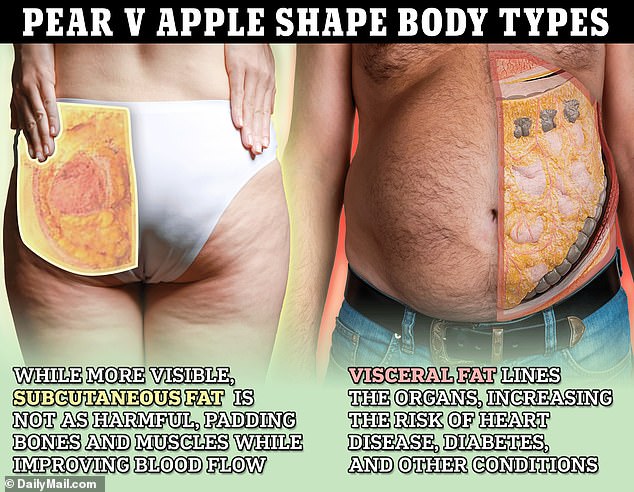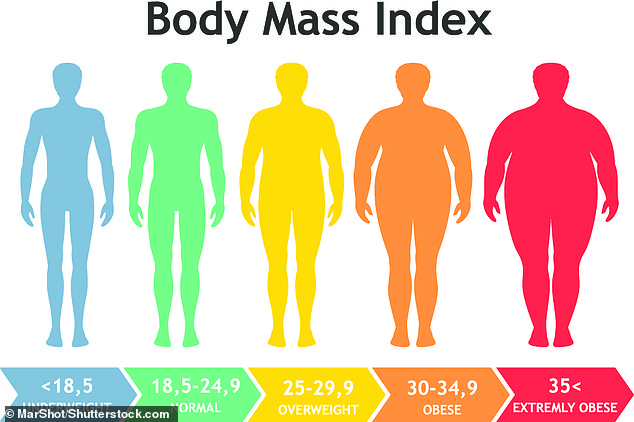Experts recommend a new way to determine health risks based on your body size, and it has nothing to do with weight.
The measurement, called body roundness index (BRI), is calculated using a person’s height and waist circumference.
Researchers have found that people with the roundest body types may be up to 163 percent more likely to develop heart disease than their peers who have thinner waists.
They say BRI may be a more accurate predictor of heart disease and death than using body mass index (BMI).
Body roundness index calculates body size including waist circumference and height, unlike body mass index which uses height and weight. This may give researchers a better idea of fat distribution in the body and may be more useful in doctors’ offices, experts say.
BMI is a widely used, but recently controversial, measure that uses a person’s height and weight to determine whether they are underweight, normal weight, overweight, obesity or extreme obesity.
There is widespread criticism of BMI as a measure, primarily because it was developed by studying wealthy white men, who have different average masses than other demographic groups.
Additionally, studies have shown that the location of fat on your body may have a greater influence on your health than the total amount of fat you have.
BMI cannot explain where fat is located on the body.
Fat that accumulates around the abdomen and vital organs has been linked to an increased risk of diabetes, high blood pressure, and heart disease.
But fat stored just under the skin, in regions such as the legs and buttocks, has not been linked to health risks.
Dr. Wenquan Niu, a LBBB researcher at Beijing Capital Institute of Pediatrics, said The New York TimesAbdominal fat is “like a silent killer lurking in our body, which can stalk a person for years with few noticeable symptoms, especially among seemingly thin people”:
Dr. Niu and his colleague’s research was published in the Journal of the American Medical Association and evaluated how well the BRI predicted mortality by analyzing data from more than 320,900 American adults over a 20-year period.
They classified the participants into five groups based on their height, weight and waist circumference. Group five had the roundest bodies, group three was average, and group one had the thinnest bodies.
They ruled out the influence of other factors such as age, sex, ethnicity, income, tobacco and alcohol consumption, family history and diabetes.
Even after accounting for them, looking at the number of deaths in each group, they found that those in the roundest group were 49 percent more likely to have died than those in the average group.

Subcutaneous fat is more visible outside the body, fills out the outer layers of muscle just under the skin, and is not linked to particular health problems. Visceral fat, found deep in the organs, is more dangerous but less visible.
Interestingly, those in groups one and four were 25 percent more likely to have died than the average group.
Similarly, a study from Nanjing Medical University that was published in the Journal of the American Heart Association found that having a consistently high BRI over a six-year period increased the risk of cardiovascular diseases, such as heart attacks and strokes, by up to 163 percent.
Study author Dr Yun Qian said this could be because obesity and high levels of abdominal fat have been linked to a number of conditions that make someone more likely to develop heart disease, such as blood pressure. high.
Dr. Qian added: “BRI measurements could potentially be used as a predictor of cardiovascular disease incidence.”

Body mass index (BMI) places people into one of five categories based solely on their height and weight. Critics say this measure is imprecise and cannot take into account things like fat distribution and muscle mass, suggesting the BRI might be better.
The tide began to turn against BMI in recent years.
In 2023, the American Medical Association recommended against widespread use in doctors’ offices.
The organization said there are: “problems with using BMI as a measure because of its historical harm, its use for racist exclusion, and because BMI is primarily based on data collected from previous generations of non-Hispanic white populations.”
This, critics say, is because the tool was created solely using data from wealthy white men. However, it is applied to measure people of all demographic groups, which critics say makes it imprecise.
Carrie Dennett, a registered dietitian nutritionist at a clinic in the Pacific Northwest, wrote for the Seattle Times: “As a measure of individual health, BMI has always been nonsense.”
They point out that BMI also cannot distinguish between muscle and fat weight. Because of that, misleading results are obtained, such as very muscular athletes being classified as obese, Dennett said.
Still, BRI isn’t perfect, he said: “BRI is ‘better’ than BMI, but it still perpetuates weight-focused healthcare.”

